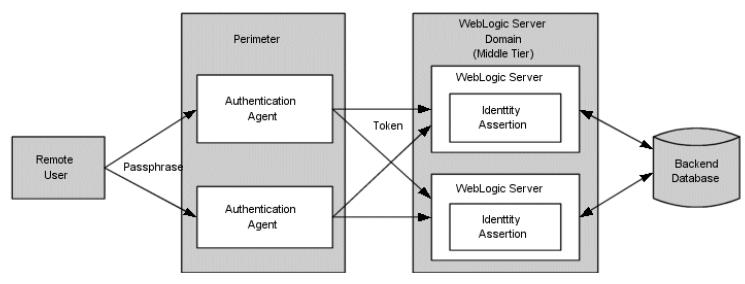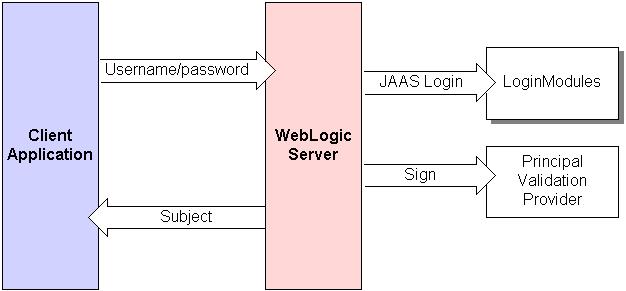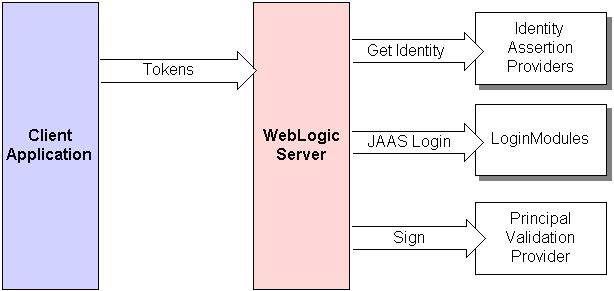I tried to discuss about „perimeter authentication“ in one extra part of IT-Security“™s blogs, because this authentication“™s process is an essential approach in a heterogonous world of systems, applications and technologies that they need to trust and communicate to each other. Generally, we discussed about perimeter authentication, if a remote user requires an asserted identity and some form of proof material to an authentication server that performs the verification and then passes an artifact, or token, to the application server domain.[1]
If we want to identify a remote user outside of the WebLogic server domain, as an authentication server, then we need to another approach for authenticating“™s process instead basic authentication with username and password[2]. This authentication“™s process is called perimeter authentication. It establishes trust via a passphrase, e.g. tokens. Tokens will be generated as part of the authentication process of users or system processes and could have many different types and / or vendors, e.g. Kerberos and Security Assertion Markup Language (SAML). WebLogic Server is able to use the token(s) so that users are not requested to sign on more than once.
This form of authentication operates with authentication agent. It performs an authentication process that outcomes in a token. It contains the authentication information of user and guarantees for the user“™s identity. The Figure1 Perimeter Authentication[3] presents the sequence of events in authenticating process:
Remote User sends a request with passphrase to Authentication Agent. It creates a token and sends to WebLogic Server to access resources and / or application(s). The WebLogic Server perform perimeter authentication via Identity Assertion.

Figure 1 Perimeter Authentication
We can define the Identity Assertion provider, as a specific form of Authentication provider that permits users or applications to assert their identity using tokens. With other words, it supports user“™s mappers, which map a valid token to a WLS-User. It is possible to develop your own or use a third-party security vendor’s Identity Assertion providers. Identity assertion can use perimeter authentication schemes such as the Security Assertion Markup Language (SAML), the Simple and Protected GSS-API Negotiation Mechanism (SPNEGO), or enhancements to protocols such as Common Secure Interoperability (CSI) v2 and support single sign-on.[4] The WebLogic Identity Assertion providers support the following token types[5] (here is a selected list of token types):
- AU_TYPE, for a WebLogicAuthenticatedUserused as a token.
- X509 is an ITU-T standard for a public key infrastructure (PKI) and Privilege Management Infrastructure (PMI) and RFC 4158 provides information and guidance for certification path building.[6]
- X509_TYPE, for an X509 client certificate used as a token:
- CSI_X509_CERTCHAIN_TYPE, for a CSIv2 X509 certificate chain identity used as a token.
„The Negotiate Identity Assertion provider is used for SSO with Microsoft clients that support the SPNEGO protocol. The Negotiate Identity Assertion provider decodes SPNEGO tokens to obtain Kerberos tokens, validates the Kerberos tokens, and maps Kerberos tokens to WebLogic users. The Negotiate Identity Assertion provider utilizes the Java Generic Security Service (GSS) Application Programming Interface (API) to accept the GSS security context via Kerberos. The Negotiate Identity Assertion provider is for Windows NT Integrated Login.“ [7]
- AUTHORIZATION_NEGOTIATE, for a SPNEGO internal token used as a token.
- WWW_AUTHENTICATE_NEGOTIATE, for a SPNEGO internal token used as a token.
„The SAML Identity Assertion providers handle SAML assertion tokens when WebLogic Server acts as a SAML destination site. The SAML Identity Assertion providers consume and validate SAML assertion tokens and determines if the assertion is to be trusted (using either the proof material available in the SOAP message, the client certificate, or some other configuration indicator).“[8] I am going back to SAML topic in an additional article(s).
- SAML_ASSERTION_B64_TYPE, for a Base64 encoded SAML.assertion used as a token.
- SAML_ASSERTION_DOM_TYPE, for a SAML DOM element used as a token.
- SAML_ASSERTION_TYPE, for a SAML string XML form used as a token.
- SAML2_ASSERTION_DOM_TYPE, for a SAML2 DOM element used as a token.
- SAML2_ASSERTION_TYPE, for a SAML2 string XML form used as a token.
- SAML_SSO_CREDENTIAL_TYPE, for a SAML string consisting of the TARGET parameter concatenated with the assertion itself and used as a token.
I introduced about Digest Authentication[9] in previous blog and WebLogic supports für Web Service application the following Digest type:
- WSSE_PASSWORD_DIGEST_TYPE, for a username token with a password type of password digest used as a token.
The Authentication and Identity Assertion Process
Now, we can compare Basic authentication Process with Identity Assertion Process. On Figure 2 Authentication Process (Principal Validation Process)[10] shows the authentication process for a fat-client login. A user attempts to log into a system using a username/password combination. WebLogic Server establishes trust by calling the configured Authentication provider’s LoginModule, which validates the user’s username and password and returns a subject that is populated with principals per Java Authentication and Authorization Service (JAAS) [11] requirements. In this way, an authentication context will be established and user can access to certain resource and / or components in WebLogic Domain.

Figure 2 Authentication Process (Principal Validation Process)
Figure 3 Perimeter Authentication presents the perimeter authentication process[12].
- A token from outside of WebLogic Server is passed to an Identity Assertion provider that is responsible for validating tokens of that type and that is configured as „active“.
- If the token is successfully validated, the Identity Assertion provider maps the token to a WebLogic Server username, and sends that username back to WebLogic Server, which then continues the authentication process as described above. It requires the same components, but also adds an Identity Assertion provider. Specifically, the username is sent via a Java Authentication and Authorization Service (JAAS)CallbackHandlerand passed to each configured Authentication provider’s LoginModule, so that the LoginModule can populate the subject with the appropriate principals.

Figure 3 Perimeter Authentication
If you compare the two ways of authentication, then you can find out a core security characteristic of WebLogic Server too. It is mean; WebLogic Server security architecture has a consistence modular structure and therefore can response rapid to new challenges and technologies in security area. This architecture is capable to expand its features und integrate new security components in itself.
[1] Oracle® Fusion Middleware: Understanding Security for Oracle WebLogic Server, 11g Release 1 (10.3.6), E13710-06
[2] For „Basic Authentication: Username/Password“ see: https://thecattlecrew.net/2014/06/05/it-security-weblogic-server-and-authentication-part-4/
[3] Oracle® Fusion Middleware: Understanding Security for Oracle WebLogic Server, 11g Release 1 (10.3.6), E13710-06
[4] Oracle® Fusion Middleware Developing Security Providers for Oracle WebLogic Server, 11g Release 1 (10.3.6), Part Number E13718-05, http://docs.oracle.com/cd/E23943_01/web.1111/e13718/ia.htm
[5] Oracle® Fusion Middleware Developing Security Providers for Oracle WebLogic Server, 11g Release 1 (10.3.6), Part Number E13718-05, http://docs.oracle.com/cd/E23943_01/web.1111/e13718/ia.htm
[6] See: http://tools.ietf.org/html/rfc4158
[7] Oracle® Fusion Middleware Developing Security Providers for Oracle WebLogic Server, 11g Release 1 (10.3.6), Part Number E13718-05, http://docs.oracle.com/cd/E23943_01/web.1111/e13718/ia.htm
[8] Oracle® Fusion Middleware Developing Security Providers for Oracle WebLogic Server, 11g Release 1 (10.3.6), Part Number E13718-05, http://docs.oracle.com/cd/E23943_01/web.1111/e13718/ia.htm
[9] See https://thecattlecrew.net/2014/06/05/it-security-weblogic-server-and-authentication-part-4/
[10] See: http://docs.oracle.com/cd/E23943_01/web.1111/e13718/atn.htm#i1141106
[11] IT-Security (Part 3): WebLogic Server and Java Security Features: https://thecattlecrew.net/2014/03/14/it-security-part-3-weblogic-server-and-java-security-features/
[12] See http://docs.oracle.com/cd/E23943_01/web.1111/e13718/ia.htm




7 Kommentare
Pingback: IT-Security: Part 1 to 5 as PDF file | Mohammad Esad-Djou's Blog
Pingback: IT-Security: Part 1 to 5 as PDF file | The Cattle Crew
Pingback: IT-Security (Part 6): WebLogic Server and Authorization | Mohammad Esad-Djou's Blog
Pingback: IT-Security (Part 6): WebLogic Server and Authorization | The Cattle Crew
Pingback: IT-Security (Part 7): WebLogic Server, Roles, Role Mapping and Configuring a Role Mapping Provider | Mohammad Esad-Djou's Blog
Pingback: IT-Security (Part 7): WebLogic Server, Roles, Role Mapping and Configuring a Role Mapping Provider | The Cattle Crew
Pingback: IT-Security (Part 5): WebLogic Server, perimeter Authentication and Identity Assertion – Mohammad Esad-Djou